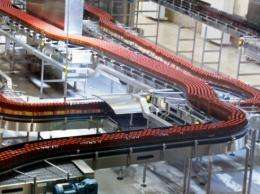Technology gives mixed meaning to labor day celebration

This Labor Day, with unemployment hovering above 9 percent, workers are confronting an enigma. Although there are one-third fewer factory workers than there were only 10 years ago, manufacturing in the United States is thriving.
From 2001-10, manufacturers shed nearly 5 million manufacturing jobs, yet the value of manufactured goods rose 27 percent, and U.S. exports reached their highest level in 20 years. Technology is not only responsible for many of the job losses -- but also for the increased output as well.
By adding technology, many manufacturers have reengineered their operations to become leaner, eliminating unnecessary steps in the manufacturing process, and replacing large inventories with more frequent shipments from suppliers. Their investments in automation made the United States a global leader in productivity, yet it hit workers with a double whammy: factories that could be automated shed people, and those that could not moved overseas.
"At some point, automation is not just about replacing a cheap person, but an enormous source of data that gives you enough information about a process to improve its quality, speed, and cost. If a human's doing it, you don't have that data," said Doug Woods, president of the Association for Manufacturing Technology.
U.S. manufacturers began boosting technology investments 20 years ago, when they realized they could not compete with low-cost offshore labor, said Tom Runiewicz, an economist at IHS Global Insight.
"The pace picked up in the recession," Runiewicz said. "There was a big squeeze on companies. They had to do more with what they had. Automation saves in the short term and makes them more competitive in the long term."
Some of these technologies are readily noticed in a factory, like robots, automated production lines, and wireless scanners for tracking parts and equipment.
Software is less visible, but is just as important. The software used in modern factories monitors and controls machinery, constantly adjusting to make each cut and weld perfect and warn when there is a problem. Other systems schedule production to use available machinery and inventory most efficiently, while others analyze production data to find better ways to complete each task.
Over the past decade, those technologies have gotten cheaper and simpler to use. "Many small and mid-sized shops are able to deploy robots now," said Joe Campbell, vice president of the ABB Robot Products Group. "Ten or 20 years ago, they needed specialists and it was more difficult to get up and running."
Tens of thousands of U.S. factories have closed since 2001, but many of those manufacturers left standing have learned to use technology to become more competitive. How competitive? A new report by Boston Consulting Group predicts that over the next five years, the cost gap between Chinese and U.S. manufacturers in some low-wage states will shrink to single digits -- without even counting shipping and inventory costs.
According to Michael Zinser, one of the report's authors, Chinese workers are averaging 15-20 percent wage increases every year. If that continues, wages in China's heavily industrialized Yangtze River Delta will go from $0.72 per hour in 2000 and $3 today to $6.30 by 2015. That is still four times less than Zinser expects U.S. workers to make, but thanks to investments in automation, American workers are far more productive. While U.S. firms are not likely to take back manual assembly work from China, Zinser says factories that use advanced technologies will be competitive.
Some companies, such as Ford, NCR, Coleman, and Peerless Industries, have shifted some production from China back to the United States. Zinser and Runiewicz believe this trend will continue. That means more jobs in the United States, though not as many as in the past. It also means a different type of workforce.
Some, like Runiewicz, believe manufacturers will have to hire more educated workers.
"The person you need is going to very technical, almost an engineer," Runiewicz said. "That type of person [unskilled factory laborers] will almost be obsolete."
Samsung Semiconductor's new semiconductor plant in Austin, Texas shows what that trend looks like. The company’s original plant employed 1,800 people. When Samsung opened a larger, more automated plant in 2007, it let go of 750 people, including 300 manual factory workers. The new plant now has 2,200 engineers, technicians, and other workers, but almost no one does manual factory work.
Yet Woods -- who apprenticed as a tool and die maker -- believes that ordinary workers have a future. He expects smarter manufacturing software to provide the specialized skills workers lack, just as word processors made it easier for everyone to write grammatical reports without spelling errors.
"The jobs are not going to be what they were 20 or 25 years ago, but there is going to be more manufacturing. We're going to employ smarter technology that will enable people without a college education to work in factories," Woods said.
Provided by Inside Science News Service















